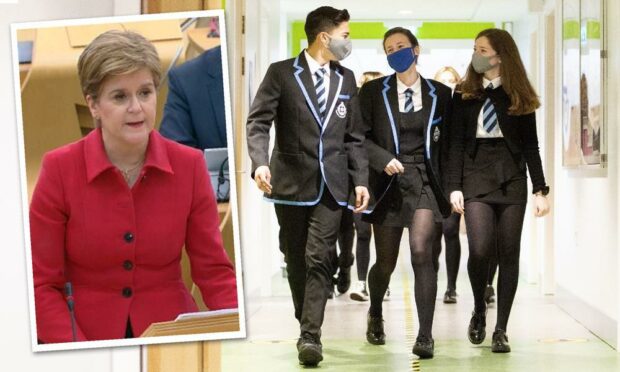Isolation of entire classes of school pupils in Scotland for single a Covid-19 case has been ruled out, despite the surge in Omicron cases.
First Minister Nicola Sturgeon confirmed school isolation will be based on risk level when she addressed the Scottish Parliament on Tuesday.
The news means that in most cases, a school close contact will not have to isolate for the whole 10 days as they will be categorised as a ‘low risk’ contact.
Ms Sturgeon also emphasised her priority to avoid as much disruption to education as possible during her briefing, where she also asked people to limit social contact.
She said: “We are not recommending that entire school classes are required to isolate when a pupil tests positive. The advice will continue to be risk based.
“A key aim is to ensure that schools stay open if at all possible to minimise further disruption to education.”
School isolation rules in Scotland
Under 18s will only have to isolate regardless of their vaccination or test status if they are a household contact of the case.
That is because school pupils aged 18 and under are only considered a ‘high risk’ contact of a person who tested positive if they live with them, have had a prolonged overnight stay with anyone outside of their home or they have had unusually close or prolonged contact with the case.
Low risk contacts – identified by schools – will normally be pupils sitting close to the positive case, or identified based on other relevant information which school leaders will have local knowledge of.
They will not normally be asked to isolate, however schools will issue guidance to those identified including important advice on “symptom vigilance, lateral flow device testing, hand hygiene and social distancing”.
Far fewer children and young people are likely to be asked to self-isolate, and when they do it will be for a shorter period of time while they await their PCR result.”
This guidance is specifically designed to avoid “blanket isolation of whole classes” after Covid-related absences began to take a toll on pupils’ education.
The guidance states: “Low risk contacts will be identified by schools (or other settings like clubs) when they receive information about relevant cases, and will send information letters that advise these low risk contacts to take certain actions.
“These do not require self-isolation but include important advice on symptom vigilance, lateral flow device testing, hand hygiene and social distancing.
“This approach means that blanket isolation of whole classes will no longer be routine. Far fewer children and young people are likely to be asked to self-isolate, and when they do it will be for a shorter period of time while they await their PCR result.”
Testing advised
While it looks unlikely schools will close as a result of the new coronavirus variant, Ms Sturgeon advised staff and pupils to remain vigilant and take measures which will help protect schools.
This includes testing during the Christmas and new year holidays.
She added: “It it is vital that schools are safe for pupils and staff.
“To help achieve this, we continue to ask secondary school pupils and all staff to take lateral flow tests regularly including during the holidays and before returning after the break and to wear face coverings.
“In addition, the advisory sub-group on education is meeting today to provide further advice on how schools can operate safely in the new year.
“We will send that advice to schools by the end of the week.”










